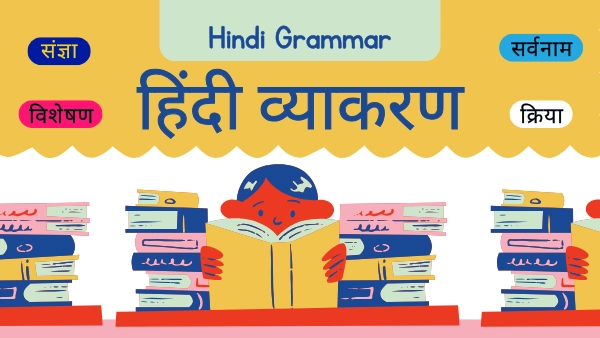We know that language is an essential medium for expressing your thoughts and opinions with others.
Even though Hindi is rich with many dialects, it's best to learn the commonly spoken, standard tongue.
To do that, you must begin by learning the Hindi alphabet (varnamala). Once you've mastered the varnamala, only then, you can move on to learning grammar.
Like any other foreign language, the Hindi language has its own rules for usage and functioning.
It is necessary to learn these elements of Hindi grammar not only to be correct with your language but know certain intricacies as well.
Sometimes, non-native speakers find it difficult to utter expressions or words like native Hindi speaker. In fact, despite learning Hindi, most beginners remain unfamiliar with common expressions for a long time.
Having said that, it does sound that Hindi is a difficult language to learn. But with little help with the grammar, I am sure you will speak like a native speaker in no time.
Let us take a look at what these grammatical terms are.
- The Basic Elements of Hindi Grammar
- 13 Building Blocks of Hindi Grammar
- 1. संज्ञा (Sangya or Noun)
- 2. सर्वनाम (Sarvanaam or Pronoun)
- 3. क्रिया (Kriya or Verbs)
- 4. विशेषण (Visheshan or Adjective)
- 5. लिंग (Ling or gender)
- 6. संधि (sandhi or union)
- 7. अनेकार्थि शब्द (anekarthi shabd or Multiple words )
- 8. पर्यायवाची शब्द (paryaayavaachii shabd or synonyms)
- 9. कारक (kaarak or factor)
- 10. वचन ( vachan or Grammatical Number )
- 11. उपसर्ग (upa-sarg or prefix)
- 12. प्रत्यय ( pratyay or suffix)
- 13. संयोजक ( san-yojak or conjunctive )
- How do you Practice Learning all These Intricacies of Hindi Grammar?
- Conclusion
- FAQs
- 1. What is the main focus of "Ins and Outs of Hindi Grammar"?
- 2. Who is this guide intended for?
- 3. Are there any exercises or examples included in the guide?
- 4. How can I access "Ins and Outs of Hindi Grammar"?
- 5. Is this guide suitable for self-study?
- 6. Does the guide cover advanced topics in Hindi grammar?
- 7. Can this guide help with speaking and writing in Hindi?
- 8. Are there any supplementary resources recommended in the guide?
- 9. How long will it take to improve my Hindi grammar using this guide?
- 10. Is there a community or support available for readers of the guide?
The Basic Elements of Hindi Grammar

क्रिया ( Kriya ) (Verb)
लिंग ( ling ) (Gender)
संधि ( Sandhi ) (Union)
अनेकार्थि शब्द ( anekarthi shabd ) (Multiple Words)
पर्यायवाची शब्द ( paryaayavaachii shabd ) (Synonyms)
कारक ( kaarak ) (Factor)
वचन ( vachan ) (Grammatical Number)
उपसर्ग ( upasarg ) (Prefix)
प्रत्यय ( pratyay ) (Suffix)
संयोजक ( san-yojak ) (Conjunctive)

These are the 13 most essential elements in Hindi Grammar that set the rules for its vocabulary.
Let's take a closer look at each one of them.

13 Building Blocks of Hindi Grammar
1. संज्ञा (Sangya or Noun)
This is just like in the English language.
A word that is used to identify the name of a person (व्यक्ति - Vyakti ), place (स्थान - Sthaan), things ( वस्तु - Vastu) or feelings ( भाव - Bhaav ) is known as संज्ञा ( sangya), i.e., noun.

It has three types.
व्यक्तिवाचक ( VyaktiVaachak / Proper noun )
जातीवचक ( JaatiVaachak / Common noun )
भाववाचक ( BhaavaVaachak / Expressive noun )
There is another type of noun that is used to identify a group of things, places, or people, which is known as समुहवाचक ( Samuhavaaachak / Collective nouns ).
Examples
Ganga, Himalay, farmer, peacock, writer, chair, book, beauty, old, smell.
2. सर्वनाम (Sarvanaam or Pronoun)
Simply put, these are words that are used in place of nouns.
There are six types
व्यक्तिवाचक सर्वनाम (vyakti vaachak sarva-naam ) ( Personal pronouns )
निश्चयवाचक सर्वनाम (Nishchay vaachak sarva-naam) ( Definite pronouns )
अनिश्चयवाचक सर्वनाम (Anishchay vaachak sarva-naam) ( Indefinite pronouns )
सम्बंधवाचक सर्वनाम (sambandh vaachak sarva-naam) ( Relative pronouns )
प्रश्नवाचक सर्वनाम (prashna vaachak sarva-naam) ( Interrogative pronouns )
निजावाचक सर्वनाम (nija vaachak sarva-naam) ( Reflexive pronouns )
The व्यक्तिवाचक सर्वनाम ( Personal pronouns )) is further divided into three categories:
उत्तम व्यक्तिवाचक सर्वनाम (Uttam purush vaachak sarva-naam)( used for yourself )
मध्यम व्यक्तिवाचक सर्वनाम (Madhyam purush vaachak sarva-naam) ( used for the listener )
अन्य व्यक्तिवाचक सर्वनाम (Anya purush vaachak sarva-naam) ( used for the other person )
3. क्रिया (Kriya or Verbs)
The words that indicate action is called क्रिया ( Kriya or Verbs ).
There are different types depending on the condition:
Depending on the action, there are two types.
सकर्मक ( Sakarmak ) क्रिया
अकर्मक ( Akarmak ) क्रिया
And depending on the basis of structure ( रचना ), there are
सामान्य ( Saamaanya ) क्रिया
प्रेरणार्थक ( Prernarthak ) क्रिया
संयुक्त ( Sanyukta ) क्रिया
नामभातु ( Naamabhaatu ) क्रिया
पूर्वकालिक ( Purvakaalika ) क्रिया
अनुकरणात्मक ( Anukaranaatmka ) क्रिया
4. विशेषण (Visheshan or Adjective)
These are simply words that describe the specialty of nouns or pronouns.
There are four types
गुणवाचक विशेषण (Guna vaachak Visheshan )
संख्यावाचक विशेषण ( sankhya vaachak Visheshan )
परिणामवाचक विशेषण ( parinaam vaachak Visheshan )
सार्वनामिक विशेषण ( Sarvanaamik Visheshan )
5. लिंग (Ling or gender)
Everything in Hindi has a gender.
The form of a noun ( संज्ञा ), pronoun ( सर्वनाम ) or verbs ( क्रिया ) that give a sense of gender of a person, thing, or a feeling is called Ling ( लिंग ) ( gender ).
There are two types of this
पुल्लिंग ( Pul-ling)( Masculine )
स्त्रीलिंग (Stree-Ling) ( Feminine )
It is not difficult to decide the gender of living things or animal nouns.
There could be a little challenge in the gender determination of non-living nouns.
Like French, Hindi also divides inanimate objects into different genders.
6. संधि (sandhi or union)
This word has been picked from Sanskrit, which means "union."
When two letters join together to form a new letter, that change in form is called sandhi (संधि)
It has three types
स्वर संधि (swar sandhi) - occurs when there is a union between two vowels
व्यंजन संधि ( vyanjan sandhi) - occurs when there is a union between a vowel and a consonant or a consonant and a consonant
विसर्ग संधि ( visarga sandhi ) - this occurs when there is a union between vowel and consonant
The स्वर संधि ( swar sandhi ) is further divided into 5 more subcategories based on length, attributes, growth, ion, and accompaniment.
7. अनेकार्थि शब्द (anekarthi shabd or Multiple words )
There are words in every language that has more than one meaning.
They give a different sense in every situation or combined with sentences.
Example
गति (Gati)
वह युद्ध में वीर गति को प्राप्त हो गया | (vaha yuddha mein vir gati ko prapt ho gaya) ( He got martyrdom in the war.)
In this context गति (Gati) means "Salvation."
वह बोहोत ही धीमी गति से चल रहे है | (vaha bohot hi dheemi gati se chal rahe hai) (He is walking very slowly.)
In this context गति (Gati) refers to "Speed."
8. पर्यायवाची शब्द (paryaayavaachii shabd or synonyms)
A word or phrase that means nearly or exactly the same as another word or phrase in the same language.
Example: शेर (sher): केसरी ( kesari ), सिंह ( sinh), वनरज ( vanaraj ) - All of these words mean the same thing, "LION"
9. कारक (kaarak or factor)
The form of a noun ( संज्ञा ) or pronouns ( सर्वनाम ) in which the relation ( सम्बन्ध ) is identified to all the words in the sentences is called कारक.
The marks which are put with the noun or pronoun to reveal the कारक are called inflection marks ( विभक्ति ).
These symbols/marks are used after the intended noun or pronouns.
There are eight types.
कर्ता (Karta) - the one who does the work
कर्म (Karmik) - effect of an action
करण (Causing) - with the help of which work is done
संप्रदन (Endowment) - for who the work is being done
अपादान (Apadan) - a sense of separation is manifested
संबंध (Relation) - relation of one thing to another is manifested
अधिकरण (Possessive) - gives an understanding of the base of the verb
संबोधन (Address) - a sense of calling someone
10. वचन ( vachan or Grammatical Number )
The form of a noun or pronoun by which its grammatical number is known is called Vachan ( वचन ).
There are two types
1. एकवचन (Ek vahcan) (Singular)
This form of a noun or pronoun that denotes the union of people or things is एकवचन ( singular ).
For example कपडा( kap-da or Cloths ), पत्ता ( Patta or leaf ), पंखा ( pan-Kha or fan ), etc.
2. बहुवचन (bahu vachan) ( Plural )
This form of a noun or pronoun that denotes a person or a thing being more than one is called as बहुवचन.
For example: रास्त (raa-sa-te or Roads), नदिया (Na-di-yan or rivers), साडीया (saa-di-yaan or sarees) etc.
11. उपसर्ग (upa-sarg or prefix)
The word उपसर्ग ( up-Sarg) is formed by combining two words (up + Sarg) उप + सर्ग where सर्ग (Sarg) is the root word.
It means adding chapters to the book or the creation.
Therefore, adding a sub syllable before the root word creates a new word with the meaning "adding first."
The syllables which are put before the word and change their meaning are called उपसर्ग (upa-Sarg).
12. प्रत्यय ( pratyay or suffix)
The syllables placed at the end of words are called प्रत्यय (suffix).
They are just like उपसर्ग. The only difference is sub syllables get added to the end of the word.
The words created give a different meaning than the original word.
सम्बन्ध सूचक शब्द ( sam-bandh suu-chak shabd or Prepositions)
These words follow nouns(संज्ञा) to establish a relationship with another term in the same sentence.
It has three main categories
Based on the usage
Based on usage, there are two types
सम्बद्ध ( sambaddha ) - used after a noun
अनुबद्ध ( anubaddha ) - used in conjunction with a noun
Based on the meaning
Based on meaning, there are twelve types
कालवाचक ( kaala vaachak or Time related )
स्थानवाचक ( sthaan vaachak or place related )
दिशवचक साधनवचक ( dishaa vaachak or direction related )
हेतुवाचक ( hetu vaachak or intention related )
विषयवाचक ( Vishay vaachak or subject related )
व्यतिरेकवाचक ( vyatirek vaachak or Others related )
विनिमयवाचक ( vinimay vaachak or Change-related )
साद्रुश्य वाचक ( sadrushya vaachak or affinity related )
विरोध वाचक ( virodh vaachak or opposition related )
सहचारण वाचक ( sahachaanran vaachak or companion related )
संग्रह वाचक ( sangraha vaachak or collection related )
तुलना वाचक ( tulna vaachak or comparison related )
Based on the origin
Based on origin, there are two types
मूल सम्बन्ध सूचक ( muul sambanch suuchak or basic linkage indicator )
यौगिक सम्बन्ध सूचक ( yaugik sambandh suuchak or compound linkage indicator )
13. संयोजक ( san-yojak or conjunctive )
संयोजक ( conjunctive ) are words that are used to link two or more sentences together.
The words that join words, phrases, or sentences are called संयोजक ( san-yojak ).
How do you Practice Learning all These Intricacies of Hindi Grammar?
We know this seems like a lot of data to learn.
But there are ways you can learn it through passive means as well.
You can self-study by listening to Hindi audio, watching movies, read Hindi literature and poetry. Indulge in art and entertainment from India.
If you start interacting with the language, things will progress faster, because all these elements are necessary to any sentence structure.
You won't even realize it but you'll be learning pronunciation and basic grammar at the same time.


Conclusion
Conversing in any language other than your native tongue is a highly sought-after skill.
Moreover, Hindi happens to be the 3rd most spoken language globally.
So if you are thinking of learning a new language, Hindi is a great choice.
Knowing the ins and outs of Hindi gives you access to a global community and insight into the culture.
Even businesses are mostly handled in Hindi, so if you want to succeed in a company.
So what are you waiting for? New learners can start practicing online using an app, email courses, or take up online Hindi courses.
Get familiar with all the grammar for the language to understand the language better.
You don't have to develop otherworldly vocabularies; be comfortable enough with the conversational Hindi to go and enjoy street food and beautiful heritage.
FAQs
1. What is the main focus of "Ins and Outs of Hindi Grammar"?
"Ins and Outs of Hindi Grammar" provides a comprehensive overview of Hindi grammar rules, including sentence structure, verb conjugations, noun usage, and pronunciation tips.
It aims to make learning Hindi grammar accessible and enjoyable for beginners and advanced learners alike.
2. Who is this guide intended for?
This guide is designed for a wide range of readers, including Hindi language learners, teachers, and anyone interested in improving their understanding of Hindi grammar. Whether you are a beginner or looking to refine your skills, this guide offers valuable insights for all levels.
3. Are there any exercises or examples included in the guide?
Yes, "Ins and Outs of Hindi Grammar" includes numerous exercises and practical examples to help reinforce the grammar concepts. You’ll find exercises at the end of each chapter to test your understanding and enhance your practical skills in using Hindi grammar.
4. How can I access "Ins and Outs of Hindi Grammar"?
The guide is available for purchase in both digital and print formats on various online platforms. Check the official website or popular bookstores to get your copy.
5. Is this guide suitable for self-study?
Absolutely! The guide is structured to facilitate self-study, with clear explanations, step-by-step instructions, and plenty of practice materials. Learners can progress at their own pace and revisit challenging concepts as needed.
6. Does the guide cover advanced topics in Hindi grammar?
Yes, "Ins and Outs of Hindi Grammar" delves into advanced topics, including compound sentences, complex tenses, and nuances of language usage. It's beneficial for learners looking to achieve fluency and grasp the subtleties of Hindi.
7. Can this guide help with speaking and writing in Hindi?
Definitely! By mastering Hindi grammar through this guide, you will improve both your speaking and writing skills. Understanding the rules of grammar will enable you to construct correct sentences, enhancing your overall communication proficiency in Hindi.
8. Are there any supplementary resources recommended in the guide?
The guide suggests a variety of supplementary resources, including online courses, language exchange programs, and Hindi language apps. These resources can provide additional practice and exposure to real-life Hindi usage, complementing what you learn from the guide.
9. How long will it take to improve my Hindi grammar using this guide?
The time it takes to improve your Hindi grammar depends on your current level and the amount of time you dedicate to studying. With consistent practice, many learners notice significant improvement within a few weeks to a few months.
10. Is there a community or support available for readers of the guide?
Yes, many readers join online forums and social media groups to discuss concepts from the guide, share tips, and provide support. Engaging with a community can enhance your learning experience and motivate you to continue improving your Hindi grammar skills.
Feel free to ask if you have any specific questions or need further clarification!


Comments